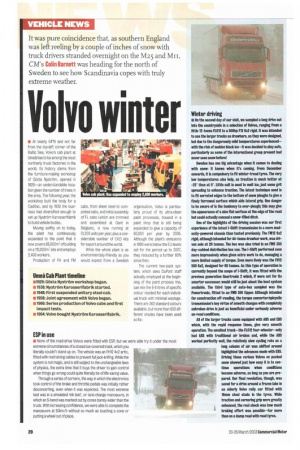Winter driving E On the second day of our visit,
Page 20

If you've noticed an error in this article please click here to report it so we can fix it.
we sampled a long drive out into the countryside in a selection of Volvos, ranging from a little 12-tonne F1.612 to a 500hp F12 6x2 rigid. It was intended to use the larger trucks as drawbars, as they were designed, but due to the dangerously mild temperatures experienced— with the risk of sudden black ice—it was decided to play safe, particularly as some of the international group present had never seen snow before!
Sweden has one big advantage when it comes to dealing with snow: it knows when it's coming. From December onwards, It is compulsory to fit winter-tread tyres. The very low temperatures also help, as traction is much better at -25than at 0-. Little salt is used to melt ice, just some grit spreading to enhance traction. The latest technique used is to fit serrated edges to the bottom of snow ploughs to give a finely furrowed surface which aids lateral grip. One danger to be aware of is the tendency to over-plough; this may give the appearance of a nice flat surface at the edge of the road but could actually conceal a snow-filled ditch.
One of the highlights of the driving session was our first experience of the latest I-Shift transmission in a more modestly-powered chassis than tested previously. The FM12 6x2 rigid, although intended for 44-tonne drawbar work, was driven solo at 26 tonnes. The box was also tried in an FM9 300 day-cabbed distribution box van. The I-Shift performed even more impressive), when given extra work to do, managing a more limited supply of torque. Even more lively was the FH12 500 6x2, designed for 60 tonnes, As this type of operation is currently beyond the scope of I-Shift, it was fitted with the previous generation Geartronic 2 which, if were not for its smarter successor, would still be just about the best system available. The third type of auto-box sampled was the Powertronic, fitted to an FM9 360 tipper. Although intended for construction off-reading, the torque converter/epicyclic transmission's key virtue of smooth changes with completely unbroken drive is just as beneficial under seriously adverse on-road conditions.
All of the larger trucks came equipped with ABS and EBS which, with the rapid response times, give very smooth operation. The smallest truck—the F1.612 four-wheeler—only had ABS with traditional air brakes and, while the ABS worked perfectly well, the relatively slow cycling rate as a long column of air was shifted around highlighted the advances made with EBS. Driving these various Volvos on packed snow showed just how easy it is to continue operations when conditions become adverse, as long as you are prepared. Our final revelation, though, was saved for a drive around a frozen lake in an elderly Volvo rally car fitted with 16mm steel studs in the tyres. While traction and cornering grip were greatly enhanced, the real shock was how much braking effort was possible—far more than on a damp road with road tyres.








































































































































































